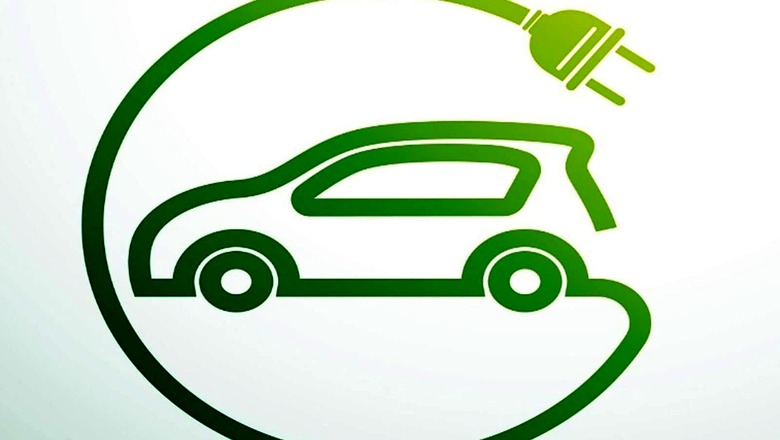
views
While India’s 2030 electric vehicles (EV) target is aggressive, it is not achievable, according to a report by the Indian Venture and Alternate Capital Association (IVCA) in collaboration with management consulting firm EY-Parthenon and law firm Indus Law.
By 2030, the central government expects the EV sales penetration to be 30% for private automobiles, 70% for commercial vehicles, and 80% for two- and three-wheelers.
But the IVCA’s report said: “The government has set a target of 80% penetration by 2030, which we feel is aggressive.”
According to the analysis, this ecosystem is currently in the “initial stages of development”, but it is also gaining traction. The researchers believed that by 2030, a realistic aim of 45-50% seems doable, especially in light of recent battery fire occurrences.
The report pinpointed the fact that EV registrations reached 330K vehicles in 2021, up 168% from 2020. Two- and three-wheelers accounted for 48% and 47% of total sales, respectively, with passenger cars accounting for 4%.
Additionally, it noted that at 45%, the e-rickshaw/e-kart category (top speed less than 25km/hour), dominates the three-wheeler market. However, others include e-buses, which account for 0.36% of the total.
As per the analysts, the increase can be linked to the demand for personal mobility, improved environmental consciousness and the rise in fuel prices.
It was also said in the report ‘Electrifying Indian Mobility’ that the second phase of incentives for Faster Adoption and Manufacturing of Hybrid and Electric vehicles (FAME II) has also aided in the increased use of electric two-wheelers.
Furthermore, the report said that in terms of investment, the EV industry received $6 billion in 2021 and is expected to get $20 billion by 2030.
It was also said that EV investors in India have shown considerable interest in the industry, with investments increasing from $181 million to $1,718 million.
According to the Ministry of Skill Development and Entrepreneurship, the EV industry will generate 1 crore direct jobs and 5 crore indirect jobs by 2030.
MARKET PREDICTIONS
As per the report, in terms of two-wheelers specifically, the numbers are estimated to reach 7.2 million vehicles with a CAGR of 68% over the next five years till 2027. The penetration percentage, according to the analysis, would be 4% in 2022, 9% in 2023, 18% in 2024, 26% in 2025, 33% in 2026 and 38% in 2027.
Similarly, for three-wheelers, it was said that the three-wheelers vehicles have seen 5% penetration in Q1-22.
“The passenger segment currently has lower penetration because only a few models are available. Cargo models are expected to see more traction primarily due to two factors: an increase in e-commerce sales and last-mile deliveries; and a commitment from Amazon and Flipkart to go 100% electric by 2030,” the report noted.
The penetration percentage in this case is expected to reach 40% by 2027.
In case of four-wheelers, the researchers stated that “we expect to see 4% penetration by 2027”. But it also highlighted a few issues which are the reasons behind the current low penetration in this section.
The report noted that there are only a handful of models in the market and they have limited range and charge slowly.
According to the analysts, in the following years, more and improved models are predicted.
There are other two factors behind the low penetration of this EV section according to the report. It said that most families have only one car, which is used for local and out-station commutes and this translates to nonfixed duty cycles.
Additionally, it said: “The current limitations in the charging infrastructure are expected to remain deterrents in the near future. There will be more traction after 2025-26, and electric cars may achieve 12% realistic penetration in the segment.”
For electric buses, the report clearly stated that the demand has been “very low”, but the section is expected to gain traction over the coming years to reach 16% penetration by 2027.
It said: “Maximum demand is from the over-aged and beyond replacement cycle (>11 years) of STU buses from six states. The supply of 5,450 buses from Tata Motors to these state STUs will help increase the penetration over the next four-five years.”
“There is traction in the intracity transportation segment due to fixed duty cycles and the availability of chargers (once the buses are operational) at the bus depots to allow for quick top-ups between duty cycles,” added the report.
However, as per the report, Uttar Pradesh leads the country in EV registrations with 20%, followed by Karnataka and Tamil Nadu.
Karnataka, Tamil Nadu, Maharashtra, Telangana, and Rajasthan account for 67% of all two-wheeler registrations. The vast majority of three-wheeler registrations are in Uttar Pradesh, Bihar, Assam, and Delhi, accounting for 75% of
total sales.
Maharashtra, on the other hand, has the largest passenger vehicle sales with 3,700 units.
CHARGING INFRASTRUCTURE
Lack of charging stations has been a concern among prospective buyers of EVs.
It should be noted that Tata Motors, Ather and Ola are establishing exclusive charging infrastructure in the country. Additionally, some of the third-party players are also providing charging solutions which include Exicom, Delta Electronics, Charge Zone, Fortum, EVtron and others.
The report also listed 18 more companies—including Ather and Tata Power—which are currently working on the charging infrastructure to electrify the county.
The analysts stated: “The lack of charging infrastructure is one of the biggest challenges for the EV sector… the limited presence of charging points means customers cannot opt for quick top-ups or charging their vehicles in emergencies.”
It further noted that there are currently just 1,742 charging stations in the country. But this figure, according to the report, is predicted to rise to 100,000 units by 2027 to meet the increased demand from the 1.4 million EVs expected to be on the road by then.
“An adequate presence of charging points, especially for fast charging, can tip the scales in favour of EVs, especially as cars and two- to four-wheelers are expected to be used for long-distance transport,” the report said.
The report further highlighted that charging infrastructure is the basis on which the EV market is constructed. As per the analysis, the country has not achieved an “expeditious pace” of establishment and use of charging infrastructure, which creates a barrier to both production and EV sales in India.
It was said that factors such as uncertainty in charging station utilisation rates, huge operating costs, load on electricity DISCOMs, and so on create a negative environment for operators to establish charging stations.
Additionally, the report stated that these also discourage investment when there are not enough EVs on Indian roads for operators to realise returns on their investments.
The report said that Indian policymakers are now taking steps to address the infrastructure issue and providing legal regulatory support for setting up charging infrastructure for EVs.
OTHER FACTORS
The report also mentioned lithium-ion batteries, which as per researchers also have “a huge environmental impact”.
It was said that if a country is deficient in materials needed to make these batteries, automakers become dependent on the availability of the same mainly through imports, which increases the cost of procurement of raw materials and manufacturing of EVs.
For example, India imported about 450 million units of lithium-ion batteries at a cost of approx $865 million between 2019 and 2020.
The report noted that major manufacturers are now looking at alternatives to li-ion batteries and a dual carbon battery, which is both less toxic and cheaper than li-ion batteries, has emerged as the prime contender.
As per the IVCA report, another option is to employ aluminium-air batteries to shift reliance to bauxite and aluminium rather than lithium, which is in short supply in India.
Separately, the analysis also talked about the research and development section in the EV ecosystem and said that “India still falls behind on strong R&D capability and consequently, manufacturers rely mostly on technological know-how borrowed from their foreign counterparts for EV components”.
It is believed that high-priority research on EV components is necessary to pave the road for the inexpensive and efficient adoption of EVs in India.
This picture, however, as per the report, is changing, and the Automotive Research Association of India has been
spearheading research on EVs and fast-charging technologies to meet the needs of the Indian market.
Rajat Tandon, President, IVCA, said: “Indian startups are keeping up with the times to have the technological edge
and the traditional companies too have quickly adapted to the change in consumer preferences.”
“The government has been very proactive and supportive with EV policies and incentives. At the same time, it’s great to see many states coming up with state-level policies to support the EV industry,” he stated.
Even though IVCA’s report applauded the central government’s initiatives to boost EV adoption in India, it also noted that the country needs to further strengthen its laws and regulations to realise its objectives of EV saturation in the Indian market.
As per the report, there are still several constraints to the manufacture and use of EVs when compared to combustion engine vehicles, which has prevented the demand side from enthusiastically accepting EVs.
It said: “Formalisation of the legal regime, initiatives for public awareness, redressal of logistical issues in the EV market are still required for seamless and fast adoption of EVs.”
Lastly, the report also suggested that Indian regulators need to:
• Push for further demand-side incentives to lower price parity between EV and ICE models.
• Concentrate on extending the method for safety ratings (used primarily for ICE variants) to EVs. This will help the consumer get confidence before making the purchase.
• Focus on incentivising firms for quick product development of their truck portfolio and the establishment of CV-specific charging points.
Read the Latest News and Breaking News here




















Comments
0 comment